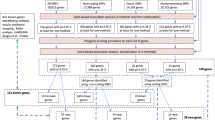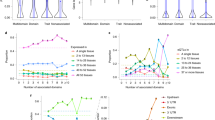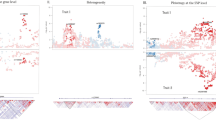Abstract
The NEO-Five-Factor Inventory divides human personality traits into five dimensions: neuroticism, extraversion, openness, conscientiousness and agreeableness. In this study, we sought to identify regions harboring genes with large effects on the five NEO personality traits by performing genome-wide linkage analysis of individuals scoring in the extremes of these traits (>90th percentile). Affected-only linkage analysis was performed using an Illumina 6K linkage array in a family-based study, the Erasmus Rucphen Family study. We subsequently determined whether distinct, segregating haplotypes found with linkage analysis were associated with the trait of interest in the population. Finally, a dense single-nucleotide polymorphism genotyping array (Illumina 318K) was used to search for copy number variations (CNVs) in the associated regions. In the families with extreme phenotype scores, we found significant evidence of linkage for conscientiousness to 20p13 (rs1434789, log of odds (LOD)=5.86) and suggestive evidence of linkage (LOD >2.8) for neuroticism to 19q, 21q and 22q, extraversion to 1p, 1q, 9p and12q, openness to 12q and 19q, and agreeableness to 2p, 6q, 17q and 21q. Further analysis determined haplotypes in 21q22 for neuroticism (P-values=0.009, 0.007), in 17q24 for agreeableness (marginal P-value=0.018) and in 20p13 for conscientiousness (marginal P-values=0.058, 0.038) segregating in families with large contributions to the LOD scores. No evidence for CNVs in any of the associated regions was found. Our findings imply that there may be genes with relatively large effects involved in personality traits, which may be identified with next-generation sequencing techniques.
This is a preview of subscription content, access via your institution
Access options
Subscribe to this journal
Receive 12 print issues and online access
$259.00 per year
only $21.58 per issue
Buy this article
- Purchase on Springer Link
- Instant access to full article PDF
Prices may be subject to local taxes which are calculated during checkout

Similar content being viewed by others
References
Crowe M, Andel R, Pedersen NL, Fratiglioni L, Gatz M . Personality and risk of cognitive impairment 25 years later. Psychol Aging 2006; 21: 573–580.
Goodwin RD, Stein MB . Peptic ulcer disease and neuroticism in the United States adult population. Psychother Psychosom 2003; 72: 10–15.
Hettema JM, Neale MC, Myers JM, Prescott CA, Kendler KS . A population-based twin study of the relationship between neuroticism and internalizing disorders. Am J Psychiatry 2006; 163: 857–864.
Kendler KS, Gatz M, Gardner CO, Pedersen NL . Personality and major depression: a Swedish longitudinal, population-based twin study. Arch Gen Psychiatry 2006; 63: 1113–1120.
Meins W, Dammast J . Do personality traits predict the occurrence of Alzheimer's disease? Int J Geriatr Psychiatry 2000; 15: 120–124.
Robertson DA, Ray J, Diamond I, Edwards JG . Personality profile and affective state of patients with inflammatory bowel disease. Gut 1989; 30: 623–626.
Shipley BA, Weiss A, Der G, Taylor MD, Deary IJ . Neuroticism, extraversion, and mortality in the UK Health and Lifestyle Survey: a 21-year prospective cohort study. Psychosom Med 2007; 69: 923–931.
Terracciano A, Lockenhoff CE, Crum RM, Bienvenu OJ, Costa Jr PT . Five-factor model personality profiles of drug users. BMC Psychiatry 2008; 8: 22.
Van Os J, Jones PB . Neuroticism as a risk factor for schizophrenia. Psychol Med 2001; 31: 1129–1134.
Jang KL, Livesley WJ, Vernon PA . Heritability of the big five personality dimensions and their facets: a twin study. J Pers 1996; 64: 577–591.
McCrae RR . NEO-PI-R data from 36 cultures: further intercultural comparisons. In: McCrae RR, Allik J (eds). The Five-Factor Model of Personality Across Cultures. Kluwer Academic Publishers/Plenum Press: New York, 2002; pp 105–125.
Costa PT, McCrae RR . Revised NEO Personality Inventory (NEO-PI-R) and NEO Five Factor Inventory (NEO-FFI) Professional Manual. Psychol Assess Res 1992.
Biesanz JC, West SG . Towards understanding assessments of the big five: multitrait–multimethod analyses of convergent and discriminant validity across measurement occasion and type of observer. J Pers 2004; 72: 845–876.
Winstow DJ, Wakefield JA, Goldsmith WM . The relationship between personality, health symptoms and disease. Person Individ Diff 1990; 11: 717–723.
Lonnqvist JE, Verkasalo M, Haukka J, Nyman K, Tiihonen J, Laaksonen I et al. Premorbid personality factors in schizophrenia and bipolar disorder: results from a large cohort study of male conscripts. J Abnorm Psychol 2009; 118: 418–423.
Wilson RS, Schneider JA, Arnold SE, Bienias JL, Bennett DA . Conscientiousness and the incidence of Alzheimer disease and mild cognitive impairment. Arch Gen Psychiatry 2007; 64: 1204–1212.
Cloninger CR, Svrakic DM, Przybeck TR . A psychobiological model of temperament and character. Arch Gen Psychiatry 1993; 50: 975–990.
Kaasinen V, Nurmi E, Bergman J, Eskola O, Solin O, Sonninen P et al. Personality traits and brain dopaminergic function in Parkinson's disease. Proc Natl Acad Sci USA 2001; 98: 13272–13277.
Menza MA, Golbe LI, Cody RA, Forman NE . Dopamine-related personality traits in Parkinson's disease. Neurology 1993; 43: 505–508.
Menza M . The personality associated with Parkinson's disease. Curr Psychiatry Rep 2000; 2: 421–426.
Canuto A, Giannakopoulos P, Meiler-Mititelu C, Delaloye C, Herrmann FR, Weber K . Personality traits influence clinical outcome in day hospital-treated elderly depressed patients. Am J Geriatr Psychiatry 2009; 17: 335–343.
Poropat AE . A meta-analysis of the five-factor model of personality and academic performance. Psychol Bull 2009; 135: 322–338.
Waller N . Evaluating the structure of personality. In: Cloninger C (ed). Personality and Psychopathology. American Psychiatric Association: Washington, DC, 1999, pp 155–197.
Riemann R, Angleitner A, Strelau J . Genetic and environmental influences on personality: a study of twins reared together using the self- and peer report NEO-FFI scales. J Pers 1997; 65: 449–475.
Loehlin JC, McCrae RR, Paul T, Costa J, John OP . Heritabilities of common and measure-specific components of the big five personality factors. J Res Pers 1998; 32: 431–453.
Jang KL, McCrae RR, Angleitner A, Riemann R, Livesley WJ . Heritability of facet-level traits in a cross-cultural twin sample: support for a hierarchical model of personality. J Pers Soc Psychol 1998; 74: 1556–1565.
Lesch KP, Bengel D, Heils A, Sabol SZ, Greenberg BD, Petri S et al. Association of anxiety-related traits with a polymorphism in the serotonin transporter gene regulatory region. Science 1996; 274: 1527–1531.
Mazzanti CM, Lappalainen J, Long JC, Bengel D, Naukkarinen H, Eggert M et al. Role of the serotonin transporter promoter polymorphism in anxiety-related traits. Arch Gen Psychiatry 1998; 55: 936–940.
Sen S, Burmeister M, Ghosh D . Meta-analysis of the association between a serotonin transporter promoter polymorphism (5-HTTLPR) and anxiety-related personality traits. Am J Med Genet 2004; 127B: 85–89.
Nash MW, Sugden K, Huezo-Diaz P, Williamson R, Sterne A, Purcell S et al. Association analysis of monoamine genes with measures of depression and anxiety in a selected community sample of siblings. Am J Med Genet B 2005; 135B: 33–37.
Luo X, Kranzler HR, Zuo L, Zhang H, Wang S, Gelernter J . CHRM2 variation predisposes to personality traits of agreeableness and conscientiousness. Hum Mol Genet 2007; 16: 1557–1568.
Calboli FC, Tozzi F, Galwey NW, Antoniades A, Mooser V, Preisig M et al. A genome-wide association study of neuroticism in a population-based sample. PLoS One 2010; 5: e11504.
Hettema JM, van den Oord EJ, An SS, Kendler KS, Chen X . Follow-up association study of novel neuroticism gene MAMDC1. Psychiatr Genet 2009; 19: 213–214.
Terracciano A, Sanna S, Uda M, Deiana B, Usala G, Busonero F et al. Genome-wide association scan for five major dimensions of personality. Mol Psychiatry 2010; 15: 647–656.
van den Oord EJ, Kuo PH, Hartmann AM, Webb BT, Moller HJ, Hettema JM et al. Genomewide association analysis followed by a replication study implicates a novel candidate gene for neuroticism. Arch Gen Psychiatry 2008; 65: 1062–1071.
Eysenck SBG, Eysenck HJ, Barrett P . A revised version of the psychotism scale. Person Individ Diff 1985; 6: 21–29.
Cloninger CR, Przybeck TR, Svrakic DM . The Tridimensional Personality Questionnaire: US normative data. Psychol Rep 1991; 69: 1047–1057.
Cloninger CR, Van Eerdewegh P, Goate A, Edenberg HJ, Blangero J, Hesselbrock V et al. Anxiety proneness linked to epistatic loci in genome scan of human personality traits. Am J Med Genet 1998; 81: 313–317.
Fullerton J, Cubin M, Tiwari H, Wang C, Bomhra A, Davidson S et al. Linkage analysis of extremely discordant and concordant sibling pairs identifies quantitative-trait loci that influence variation in the human personality trait neuroticism. Am J Hum Genet 2003; 72: 879–890.
Gillespie NA, Zhu G, Evans DM, Medland SE, Wright MJ, Martin NG . A genome-wide scan for Eysenckian personality dimensions in adolescent twin sibships: psychoticism, extraversion, neuroticism, and lie. J Pers 2008; 76: 1415–1446.
Kuo PH, Neale MC, Riley BP, Patterson DG, Walsh D, Prescott CA et al. A genome-wide linkage analysis for the personality trait neuroticism in the Irish affected sib-pair study of alcohol dependence. Am J Med Genet B 2007; 144B: 463–468.
Nash MW, Huezo-Diaz P, Williamson RJ, Sterne A, Purcell S, Hoda F et al. Genome-wide linkage analysis of a composite index of neuroticism and mood-related scales in extreme selected sibships. Hum Mol Genet 2004; 13: 2173–2182.
Neale BM, Sullivan PF, Kendler KS . A genome scan of neuroticism in nicotine dependent smokers. Am J Med Genet B 2005; 132: 65–69.
Wray NR, Middeldorp CM, Birley AJ, Gordon SD, Sullivan PF, Visscher PM et al. Genome-wide linkage analysis of multiple measures of neuroticism of 2 large cohorts from Australia and the Netherlands. Arch Gen Psychiatry 2008; 65: 649–658.
Miller SA, Dykes DD, Polesky HF . A simple salting out procedure for extracting DNA from human nucleated cells. Nucleic Acids Res 1988; 16: 1215.
Van Gestel S, Houwing-Duistermaat JJ, Adolfsson R, van Duijn CM, Van Broeckhoven C . Power of selective genotyping in genetic association analyses of quantitative traits. Behav Genet 2000; 30: 141–146.
Liu F, Kirichenko A, Axenovich TI, Duijn CMV, Aulchenko YS . An approach for cutting large and complex pedigrees for linkage analysis. Eur J Hum Genet 2008 (in press).
Abecasis GR, Cherny SS, Cookson WO, Cardon LR . Merlin—rapid analysis of dense genetic maps using sparse gene flow trees. Nat Genet 2002; 30: 97–101.
Kong A, Cox NJ . Allele-sharing models: LOD scores and accurate linkage tests. Am J Hum Genet 1997; 61: 1179–1188.
McPeek MS . Optimal allele-sharing statistics for genetic mapping using affected relatives. Genet Epidemiol 1999; 16: 225–249.
Sobel E, Lange K . Descent graphs in pedigree analysis: applications to haplotyping, location scores, and marker-sharing statistics. Am J Hum Genet 1996; 58: 1323–1337.
Sobel E, Papp JC, Lange K . Detection and integration of genotyping errors in statistical genetics. Am J Hum Genet 2002; 70: 496–508.
Horvath S, Xu X, Laird NM . The family based association test method: strategies for studying general genotype–phenotype associations. Eur J Hum Genet 2001; 9: 301–306.
Laird NM, Horvath S, Xu X . Implementing a unified approach to family-based tests of association. Genet Epidemiol 2000; 19 (Suppl 1): S36–S42.
Conlin LK, Thiel BD, Bonnemann CG, Medne L, Ernst LM, Zackai EH et al. Mechanisms of mosaicism, chimerism and uniparental disomy identified by single nucleotide polymorphism array analysis. Hum Mol Genet 2010; 19: 1263–1275.
Yau C, Holmes CC . CNV discovery using SNP genotyping arrays. Cytogenet Genome Res 2008; 123: 307–312.
Almasy L, Blangero J . Multipoint quantitative-trait linkage analysis in general pedigrees. Am J Hum Genet 1998; 62: 1198–1211.
Rosellini AJ, Brown TA . The NEO Five-Factor Inventory: latent structure and relationships with dimensions of anxiety and depressive disorders in a large clinical sample. Assessment 2011; 18: 27–38.
Durner M, Vieland VJ, Greenberg DA . Further evidence for the increased power of LOD scores compared with nonparametric methods. Am J Hum Genet 1999; 64: 281–289.
Clerget-Darpoux F, Bonaiti-Pellie C, Hochez J . Effects of misspecifying genetic parameters in lod score analysis. Biometrics 1986; 42: 393–399.
Pardo LM, MacKay I, Oostra B, van Duijn CM, Aulchenko YS . The effect of genetic drift in a young genetically isolated population. Ann Hum Genet 2005; 69: 288–295.
Verbeek DS, van de Warrenburg BP, Wesseling P, Pearson PL, Kremer HP, Sinke RJ . Mapping of the SCA23 locus involved in autosomal dominant cerebellar ataxia to chromosome region 20p13–12.3. Brain 2004; 127: 2551–2557.
Zhou B, Westaway SK, Levinson B, Johnson MA, Gitschier J, Hayflick SJ . A novel pantothenate kinase gene (PANK2) is defective in Hallervorden–Spatz syndrome. Nat Genet 2001; 28: 345–349.
Altafaj X, Dierssen M, Baamonde C, Marti E, Visa J, Guimera J et al. Neurodevelopmental delay, motor abnormalities and cognitive deficits in transgenic mice overexpressing Dyrk1A (minibrain), a murine model of Down's syndrome. Hum Mol Genet 2001; 10: 1915–1923.
Capone GT . Down syndrome: advances in molecular biology and the neurosciences. J Dev Behav Pediatr 2001; 22: 40–59.
Andelfinger G, Tapper AR, Welch RC, Vanoye CG, George Jr AL, Benson DW . KCNJ2 mutation results in Andersen syndrome with sex-specific cardiac and skeletal muscle phenotypes. Am J Hum Genet 2002; 71: 663–668.
Zhu X, Rottkamp CA, Hartzler A, Sun Z, Takeda A, Boux H et al. Activation of MKK6, an upstream activator of p38, in Alzheimer's disease. J Neurochem 2001; 79: 311–318.
van der Flier WM, Schoonenboom SN, Pijnenburg YA, Fox NC, Scheltens P . The effect of APOE genotype on clinical phenotype in Alzheimer disease. Neurology 2006; 67: 526–527.
Karayiorgou M, Morris MA, Morrow B, Shprintzen RJ, Goldberg R, Borrow J et al. Schizophrenia susceptibility associated with interstitial deletions of chromosome 22q11. Proc Natl Acad Sci USA 1995; 92: 7612–7616.
Deng HW, Chen WM, Recker RR . QTL fine mapping by measuring and testing for Hardy-Weinberg and linkage disequilibrium at a series of linked marker loci in extreme samples of populations. Am J Hum Genet 2000; 66: 1027–1045.
Goring HH, Terwilliger JD, Blangero J . Large upward bias in estimation of locus-specific effects from genomewide scans. Am J Hum Genet 2001; 69: 1357–1369.
Acknowledgements
The ERF study was further supported by grants from the Netherlands Organization for Scientific Research (NWO), Erasmus University Medical Center, the Centre for Medical Systems Biology (CMSB1 and CMSB2) of the Netherlands Genomics Initiative (NGI) and Leiden University Medical Centre (LUMC) for genotyping. We are grateful to all patients and their relatives, general practitioners and neurologists for their contributions and to Petra Veraart for her help in genealogy, Jeannette Vergeer for the supervision of the laboratory work and Peter Snijders for his help in data collection. ESG was supported by The International Human Frontier Science Program Organization.
Author information
Authors and Affiliations
Corresponding author
Ethics declarations
Competing interests
The authors declare no conflict of interest.
Additional information
Supplementary Information accompanies the paper on the Molecular Psychiatry website
Supplementary information
PowerPoint slides
Rights and permissions
About this article
Cite this article
Amin, N., Schuur, M., Gusareva, E. et al. A genome-wide linkage study of individuals with high scores on NEO personality traits. Mol Psychiatry 17, 1031–1041 (2012). https://doi.org/10.1038/mp.2011.97
Received:
Revised:
Accepted:
Published:
Issue Date:
DOI: https://doi.org/10.1038/mp.2011.97
Keywords
This article is cited by
-
Finding associations in a heterogeneous setting: statistical test for aberration enrichment
Genome Medicine (2021)
-
A rare missense variant in RCL1 segregates with depression in extended families
Molecular Psychiatry (2018)
-
SNP-based heritability estimates of the personality dimensions and polygenic prediction of both neuroticism and major depression: findings from CONVERGE
Translational Psychiatry (2016)
-
Pharmacogenomics of drug-metabolizing enzymes: a recent update on clinical implications and endogenous effects
The Pharmacogenomics Journal (2013)
-
Refining genome-wide linkage intervals using a meta-analysis of genome-wide association studies identifies loci influencing personality dimensions
European Journal of Human Genetics (2013)



